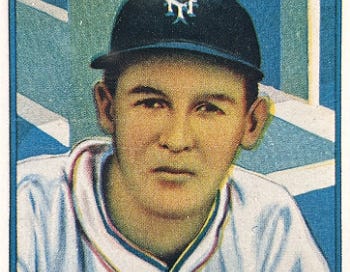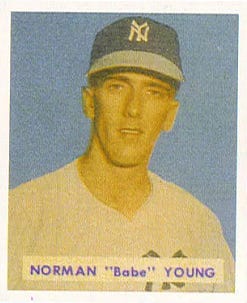Note: When you click on links to various merchants in this newsletter and make a purchase, this can result in this newsletter earning a commission. Affiliate programs and affiliations include, but are not limited to, the eBay Partner Network and Amazon Associates.
1941 Play Ball Babe Young (#27) - Card of the Day
(affiliate link)
You’d be hard-pressed to find a name that embodies the eternal youth of baseball, or at least of our baseball memories, than Babe Young.
Born Norman Robert Young in 1915, Young started his professional baseball journey with the New York Giants in September 1936 at age 21 after graduating from Fordham University.
After a single plate appearance in his debut, though, young Young would spend most of the next two seasons in the minors before returning to the Polo Grounds for good in 1939.
During those bush-league years, he showed good power and all the signs of developing into what his 1940 Play Ball rookie card called a “long-range socker”:
(affiliate link)
Here’s the front of that card:
(affiliate link)
As you can see, Young was already “Babe” by then. A consequence of his youth? Or maybe of his burgeoning power and his debut just a year after Babe Ruth played his last game?
Hard to say. There doesn’t seem to be much written about Young, and especially not his moniker.
What’s for sure, though, is that Young nabbed the Giants’ first base job in 1940 and hit .286 with 17 home runs and 101 RBI. He received some MVP votes for his work and was an easy choice for inclusion in the last major baseball card sets before the United States entered World War II.
Those included:
Two 1941 Double Play cards - #32 with Mel Ott at #31, and #93 with Cliff Melton at #94
1941 Goudey #23 with four color variations (yellow, green, blue, red)
1941 Play Ball #27
That last one, the Play Ball, is the best-looking of the bunch, at least to my eyes, and that’s why it nabs our “Card of the Day” honors at the top of this post.
Whatever your choosing, Babe Young baseball cards and even Babe Young baseball appearances were slim pickings from there on out.
Young played 101 games in 1942, when there weren’t any baseball cards aside from a few regional issues, before spending 1943 through 1945 in the military. He was back with the Giants in 1946, then split 1947 between New York and the Reds.
Still not much in the way of baseball cards those years, but they started to come back in 1948, with Bowman and (sorta) Leaf (kind of a 1948-49 issue). Young didn’t make the cut in either set, and his performance on the diamond tumbled at age 32 — .237, 2 HR, 25 RBI in 90 games for the Reds and Cardinals.
That was the end of the road for Young in the majors but he did score a career-capper baseball card in the 1949 Bowman set (#240).
Sort of…
(affiliate link)
If that Yankees cap looks wrong, that’s because it is. The card actually shows Bobby Young (at least according to BaseballCardPedia.com and TCDB)…though Bobby never played for the Yankees, either.
Whatever the case, Bowman was convinced enough that they had Babe Young to give him a proper bio and cardboard sendoff on the card back:
(affiliate link)
You might have noticed, too, that this Young is pretty advanced in terms of the 1949 Bowman issue — it’s the last card in the set.
Today, we can use all this to celebrate the eternal youth of baseball and the rebirth of the hobby after the war and the joys of career-cappers and set-enders all courtesy of one man.
Because Norman Robert “Babe” Young was born on July 1, 1915. And, really, 110 years is nothing when you’re forever young.
1986 Fleer Update Tony Walker the Beginning of a Good Thing?
Also born on July 1 (in 1959) was former Astros outfielder/pinch-runner Tony Walker. Following his 1986 debut, Walker landed in the 1986 Fleer Update set. As it turned out, the image they used had longer legs than Walker’s big league career. Read all about it right here.









